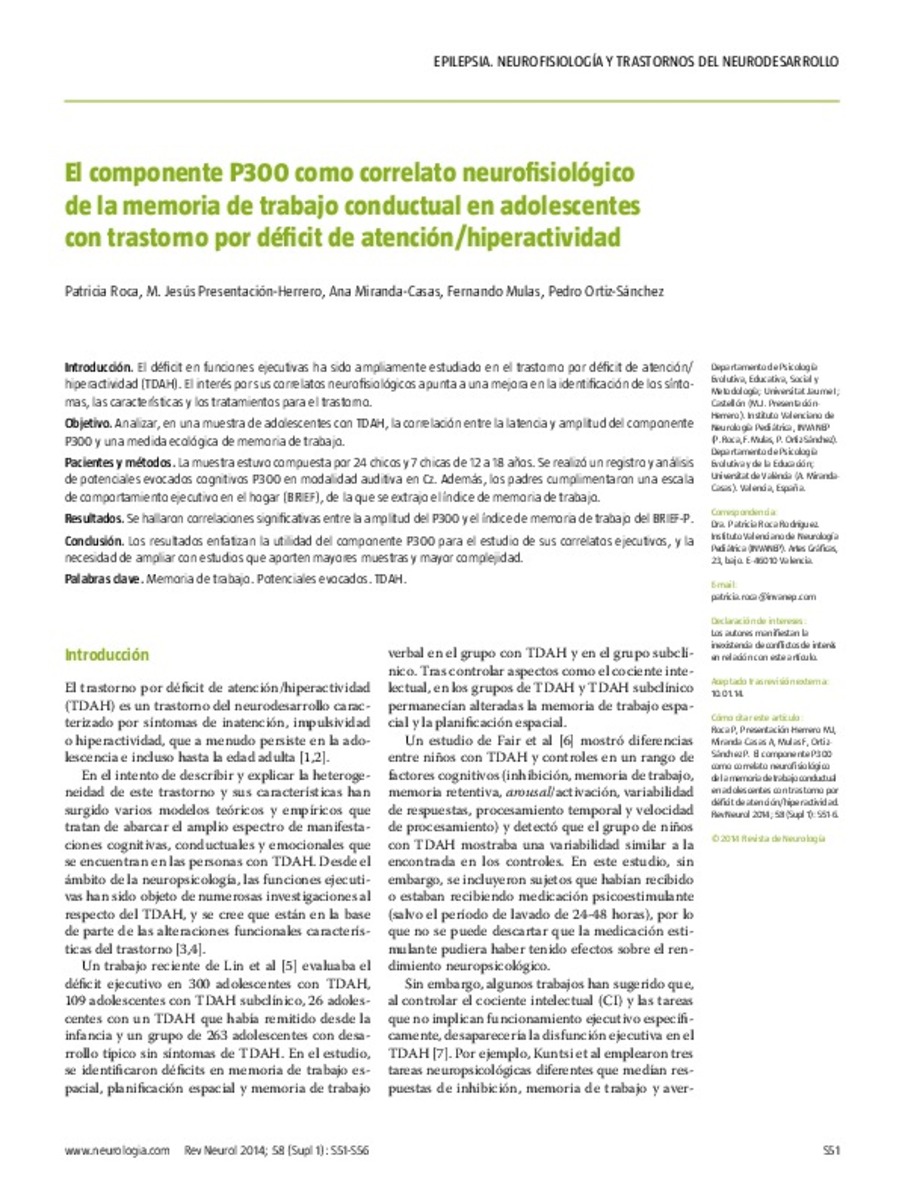| dc.contributor.author | Presentación, M. Jesús | |
| dc.contributor.author | Roca, Patricia | |
| dc.contributor.author | Miranda Casas, Ana | |
| dc.contributor.author | Ortiz Sánchez, Pedro | |
| dc.contributor.author | Mulas Delgado, Fernando | |
| dc.date.accessioned | 2015-09-02T11:11:35Z | |
| dc.date.available | 2015-09-02T11:11:35Z | |
| dc.date.issued | 2014 | |
| dc.identifier.citation | ROCA, Patricia, et al. El componente P300 como correlato neurofisiológico de la memoria de trabajo conductual en adolescentes con trastorno por déficit de atención/hiperactividad. Rev Neurol, 2014, vol. 58, no Supl 1, p. S51-6. | ca_CA |
| dc.identifier.issn | 0210-0010 | |
| dc.identifier.issn | 1576-6578 | |
| dc.identifier.uri | http://hdl.handle.net/10234/130761 | |
| dc.description.abstract | Deficit in the executive functions has been widely studied in attention deficit hyperactivity disorder (ADHD). The interest in its neurophysiological correlates has led to an immprovement in the identification of the symptoms, the characteristics and the treatment of the disorder. The objective of this study was to analyse the correlation between latency and amplitude of the P300 component and an ecological measure of working memory in a sample of adolescents. Patients and methods. The sample consisted of 24 boys and 7 girls aged between 12 and 18 years. P300 cognitive evoked potentials in auditory mode at Cz were registered and analysed. Furthermore, the parents filled in an executive behaviour home rating scale (BRIEF), which the working memory index was extracted from. Results. Significant correlations were found between the P300 amplitude and the working memory index of the BRIEF-P. Conclusions. Results underline the usefulness of the P300 component for the study of its executive correlates, as well as the need to conduct further studies involving larger samples and greater complexity | ca_CA |
| dc.description.abstract | Introducción. El déficit en funciones ejecutivas ha sido ampliamente estudiado en el trastorno por déficit de atención/hiperactividad (TDAH). El interés por sus correlatos neurofisiológicos apunta a una mejora en la identificación de los síntomas, las características y los tratamientos para el trastorno. Objetivo. Analizar, en una muestra de adolescentes con TDAH, la correlación entre la latencia y amplitud del componente P300 y una medida ecológica de memoria de trabajo.
Pacientes y métodos. La muestra estuvo compuesta por 24 chicos y 7 chicas de 12 a 18 años. Se realizó un registro y análisis de potenciales evocados cognitivos P300 en modalidad auditiva en Cz. Además, los padres cumplimentaron una escala de comportamiento ejecutivo en el hogar (BRIEF), de la que se extrajo el índice de memoria de trabajo. Resultados. Se hallaron correlaciones significativas entre la amplitud del P300 y el índice de memoria de trabajo del BRIEF-P. Conclusión. Los resultados enfatizan la utilidad del componente P300 para el estudio de sus correlatos ejecutivos, y la necesidad de ampliar con estudios que aporten mayores muestras y mayor complejidad. | ca_CA |
| dc.format.extent | 6 p. | ca_CA |
| dc.format.mimetype | application/pdf | ca_CA |
| dc.language.iso | spa | ca_CA |
| dc.publisher | Viguera Editores | ca_CA |
| dc.rights.uri | http://rightsstatements.org/vocab/CNE/1.0/ | * |
| dc.subject | memoria de trabajo | ca_CA |
| dc.subject | potenciales evocados | ca_CA |
| dc.subject | TDAH | ca_CA |
| dc.subject | ADHD | ca_CA |
| dc.subject | evoked potentials | ca_CA |
| dc.subject | working memory | ca_CA |
| dc.title | El componente P300 como correlato neurofisiológico de la memoria de trabajo conductual en adolescentes con trastorno por déficit de atención/hiperactividad | ca_CA |
| dc.type | info:eu-repo/semantics/article | ca_CA |
| dc.rights.accessRights | info:eu-repo/semantics/openAccess | ca_CA |
| dc.relation.publisherVersion | http://www.neurologia.com/pdf/Web/58S01/blS01S051.pdf | ca_CA |
| dc.type.version | info:eu-repo/semantics/publishedVersion | ca_CA |







